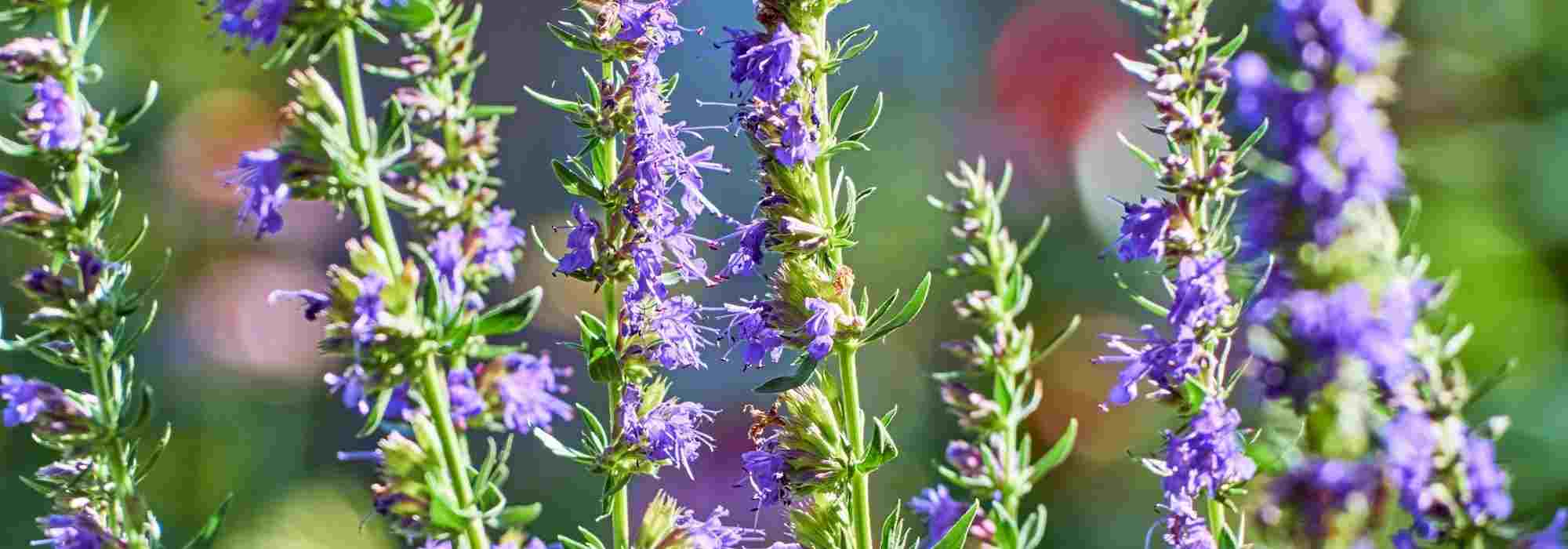
Associate Hyssop
Some ideas to guide you
Contents
Aromatic, culinary, medicinal, melliferous, undemanding… there is no shortage of adjectives to describe the Hyssop, a small undershrub from the Mediterranean region, which thrives in sunny locations and well-drained soils typical of this area.
With its flowers generally blue, sometimes white, or even pink, clustered in upright inflorescences resembling those of lavender, and its semi-evergreen foliage, the Hyssopus finds its place in many gardens, from the most natural to the most contemporary.
Here are some ideas for pairing it and showcasing it in the garden!
Spiralled herb garden or gourmet planter
If you wish to create a square or a spiralled herb garden, include hyssop in it. In the Middle Ages, it was indeed cultivated in vicar’s gardens. It is even mentioned in the Capitulaire de Villis, a reference text dating back to the 8th century.
When planting herbs, it is important to consider their specific needs. Some prefer dry, warm soils, while others thrive in cool, humus-bearing soils.
Hyssop will thrive in full sun and dry soil, alongside thyme, rosemary, summer savoury, and sage, which have the same requirements as it. If you have opted for the spiral, place the hyssop at the very top. If you have limited space, you can also plant hyssop in a large container with other herbs, which you can place close to the kitchen.

Hyssopus officinalis, Rosmarinus officinalis, Satureja montana, and Salvia officinalis
Mediterranean garden
The Mediterranean garden is sometimes referred to as a dry garden. Hyssop will thrive with its beautiful flowering in an intense blue and its small semi-evergreen leaves alongside lavender.
This type of garden is not exclusive to the South of France. In cooler and wetter regions, you can create a rockery with plants that tolerate lower temperatures. It is essential to ensure that the soil is very well-draining, as what Mediterranean plants generally fear the most is the combination of frost and waterlogged soil, which is fatal for the roots.
The silver Santolina and Helichrysum, other typical rockery plants and therefore good companions for hyssop, will provide a beautiful contrast with their grey foliage and yellow flowering.
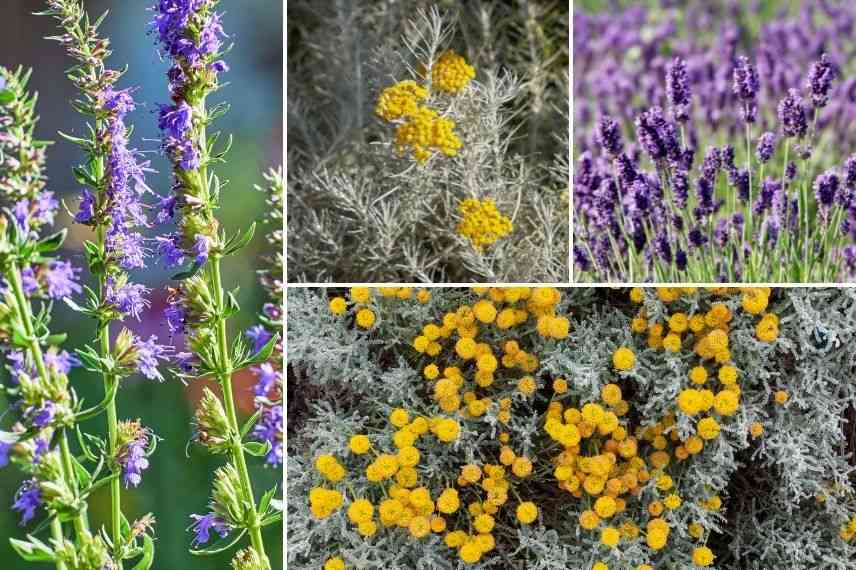
Hyssopus officinalis, Helichrysum italicum, Lavandula angustifolia and Santolina chamaecyparissus
Discover other Hyssopus
View all →Available in 2 sizes
Available in 0 sizes
Available in 1 sizes
Available in 1 sizes
Cottage garden
The English garden or cottage garden is a place imbued with softness and a very natural appearance. Soft and pastel shades predominate here. Thanks to its rounded habit, Hyssop fits perfectly into this atmosphere. It is even possible to play with the flowering in different colours – blue, white, or pink.
The Sage Salvia nemerosa ‘Caradonna’, with its beautiful intense violet colour, pairs well with Hyssop, while the hardy geraniums with their light flowering soften the overall effect.
The Hydrangeas and Nepetas, both iconic plants of English-style gardens, will complete the picture with their rounded habit. Finally, Heucheras are also essential.
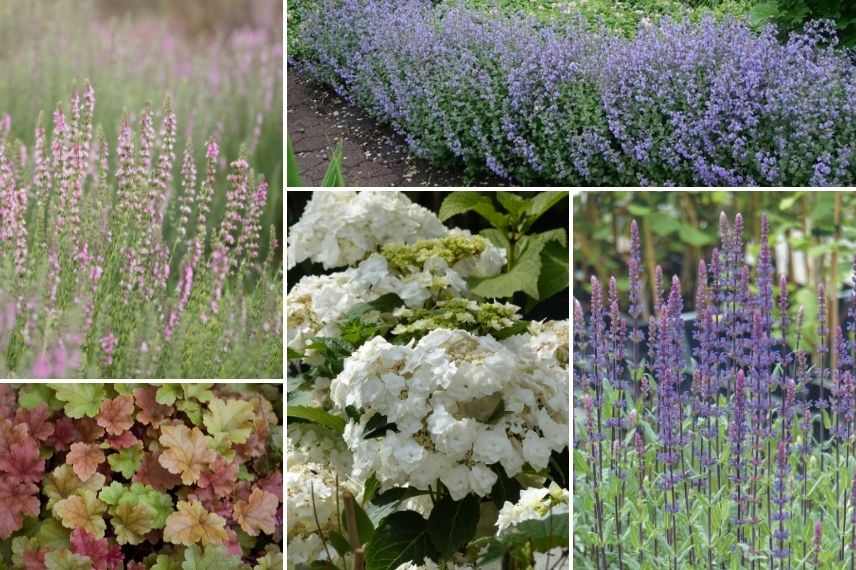
Hyssopus officinalis with pink flowers, Nepeta, Heuchera, Hydrangea macrophylla ‘Wedding Gown’, and Salvia nemorosa ‘Caradonna’
Read also
How to dry and use hyssop?Naturalist garden
In a naturalistic garden – or natural – the aim is to promote biodiversity, both in terms of plants and animals, particularly through melliferous plants that will attract numerous pollinators. The Hyssop is particularly interesting in this regard.
In shades of blue, it can be paired with Borage, Phacelia, and Viper’s Bugloss, which are both easy and useful plants. Blue-flowering Agastaches like Agastache ‘Blue Boa’ and Agastache ‘Black Adder’, as well as Perovskia, or Russian sage, can complement this colour palette.
To soften the cool tones provided by the blues, Gauras and Chinese fountain grasses will be added, which will also bring movement with their tall stems swaying gracefully in the wind.
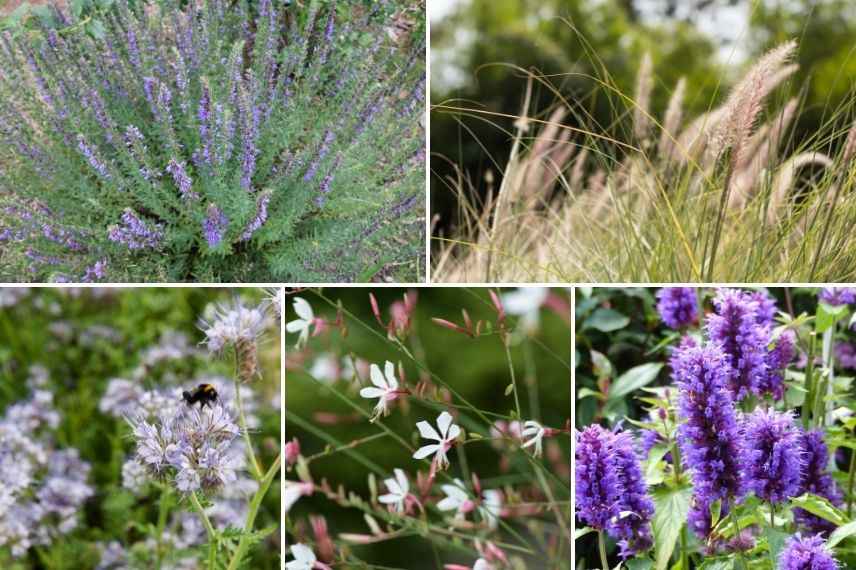
Hyssopus officinalis, Chinese fountain grass, Phacelia tanacetifolia, Gaura, and Agastache ‘Blue Boa’
Romantic garden
The rose is the emblematic flower of any self-respecting romantic garden. You can choose a white one to offset the melancholy of blue. Gauras will add lightness.
Additionally, opt for flowers in pink hues, including Hyssop with the variety ‘Roseus’. Purple Echinaceas, Dianthus carnations, and Lychnis have delicate flowerings and refined foliage that create a beautiful effect. This is also true for blue or white Campanulas.
To add structure, include boxwood trimmed into balls; these topiaries will persist all year round. Irises with their upright foliage can also play this role. They additionally have spectacular flowering, just like the Agapanthus.
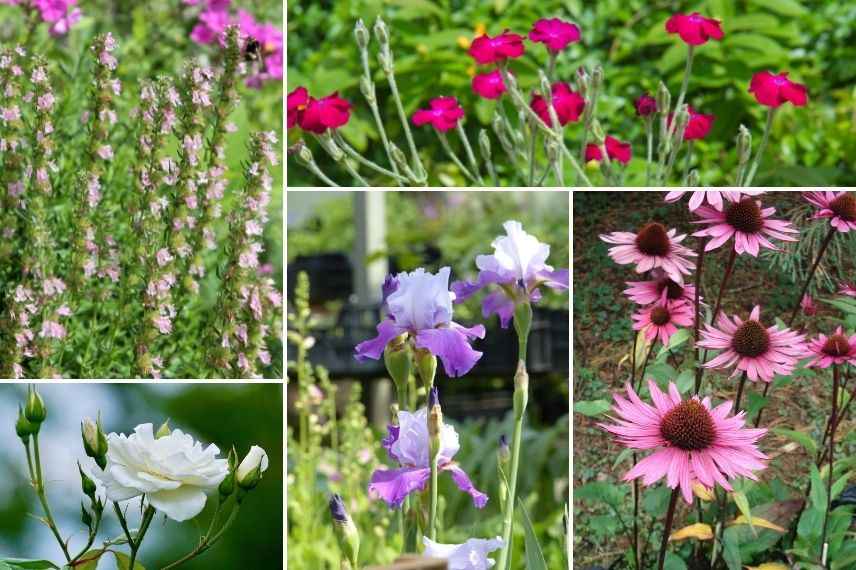
Hyssopus officinalis ‘Roseus’, Lychnis coronaria, white rose, Iris germanica ‘Carl and Sissy’, and Echinacea purpurea ‘Fatal Attraction’
Contemporary garden
Hyssop clumps have a naturally rounded habit that can be quite graphic and give a modern style to your garden.
To achieve a mass effect, you can plant alignments of Hyssop and Lavender. Their fine foliage will complement each other, in slightly different tones. Some boxwoods trimmed into balls can echo them, like punctuation with their small, glossy green round leaves. In case of diseases or attacks from the box tree moth, you can easily replace them with shrubby honeysuckles Lonicera nitida, which will also tolerate pruning. Some white or blue Agapanthus will add verticality with their stems carrying the umbels high above the tuft of ribbon-like leaves. A mulch of white pebbles, in addition to preventing excess moisture at the base of these rather dry-soil plants, will serve as a backdrop.
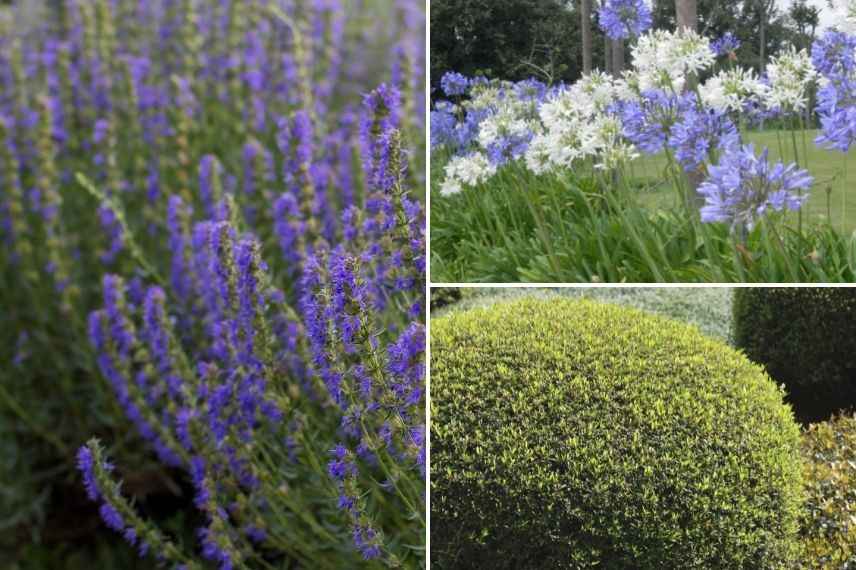
Hyssopus officinalis, white and blue Agapanthus, and topiary
Orange-Blue Flower Bed
Want some colour? Try strong contrasts by pairing blue-flowering and orange-flowering plants.
The intense blue and upright flowering of Hyssop lasts all summer. Larkspurs and Agastaches will also provide long blooms in the same blue tones and can be included in borders.
Next, choose orange flowers to create your scene. For a natural look, these plants can be paired with Nasturtiums and California Poppies. These annual plants will generally self-seed easily from one year to the next.
For a more exotic atmosphere, turn to Crocosmias and other Cannas, with their upright habit and vibrant blooms. Also add a blue Agapanthus, which will also bring a graphic touch. These are the advantage of being perennials.

Crocosmia, Hyssopus officinalis, Eschscholzia californica, blue Agapanthus and Tropaeolum majus
- Subscribe!
- Contents
































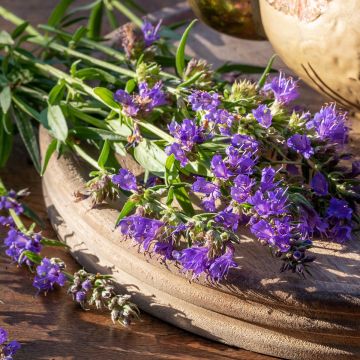

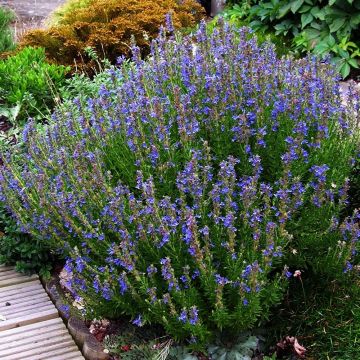

Comments